From Shaft to SMASH: An Exclusive Interview with Costume Designer Joseph G. Aulisi
The 7th Annual Outstanding Art of Television Costume Design features a large group of costumes from the television show SMASH. With costumes designed by Joseph G. Aulisi, SMASH chronicled the ups and downs of an ensemble cast as they launched a Broadway show. In this exclusive interview, Mr. Aulisi reveals the breakneck pace of working on SMASH and shares highlights from his career.
See costumes from SMASH and many other television shows in The 7th Annual Outstanding Art of Television Costume Design exhibition at the FIDM Museum through October 19, 2013. Open 10-5, Tuesday through Saturday, this FREE exhibition is a wonderful look at the costumes that create our favorite television shows.
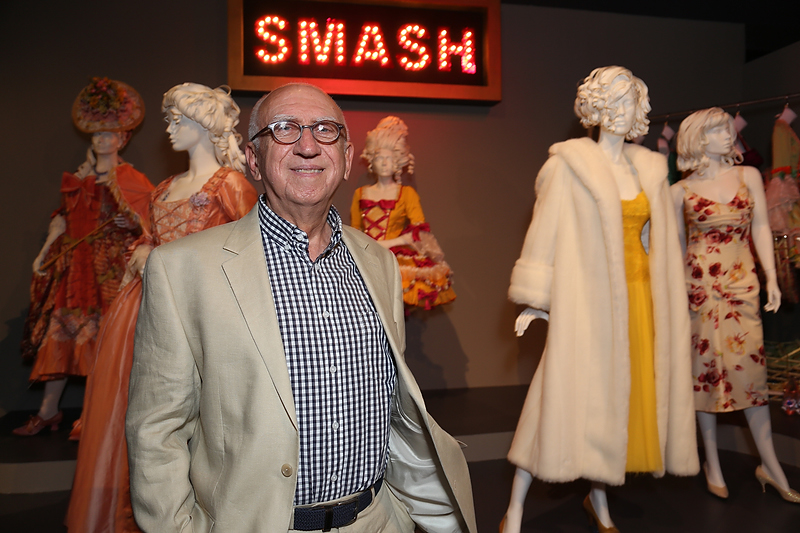 Joseph G. Aulisi, costume designer for SMASH
Joseph G. Aulisi, costume designer for SMASH
How did you manage the design process for the contemporary pieces along with the costumes for the two Broadway musicals within SMASH?
Everything for the musical numbers in the Bombshell and Liaison sequences was made to order, mostly within one or two weeks. I go into the shop and sketch, start selecting fabrics, make the muslin versions and do the fittings, then the regular fittings, and finally deliver them the night before the next morning’s shoot. Often there were 12 to 16 dancers to clothe, along with the principals’ costumes.
Were you able to rent any costumes?
No, and that was part of the challenge. Having the ideas and doing the sketches comes quite easily. Getting the costume houses to produce them in the time required was not so easy. Two or three houses worked at the same time on just one number.
When did you do your fittings?
We had to work around the shooting schedule, because we were always shooting one episode as we were prepping another one. Dancers had rehearsals and many of the principals had singing rehearsals. It was a bit of a logistical trick because we shot and rehearsed mostly in Queens NY, while all the costumes houses are in Manhattan.
No Season 3 of SMASH?
It’s a shame that it wasn’t picked up, but you know, that’s show business.
Did you do a lot of research for SMASH?
I have done 35 Broadway shows, including lots of musicals. In the process of working with Jerome Robbins, Tommy Tune, Michael Bennett, and many more, I have done the research.
The strange thing about this is that the Marilyn musical that SMASH refers to was produced in 1983 and it closed after 17 performances. The actual Broadway show, Marilyn: An American Fable, is referred to in SMASH as a big bomb. Naturally, the Marilyn musical in SMASH is called Bombshell. I knew the Marilyn territory quite well, because I designed the costumes for the 1980s flop.
Besides Bombshell, there is another Broadway play within SMASH—Liaisons.
Liaisons was a lot of fun to do. I kept to the 1770s silhouette, then added decorations and a palette that was very bold. I was inspired to dress the nine showgirls like French macaroons. It was great fun and pretty silly and whimsical.
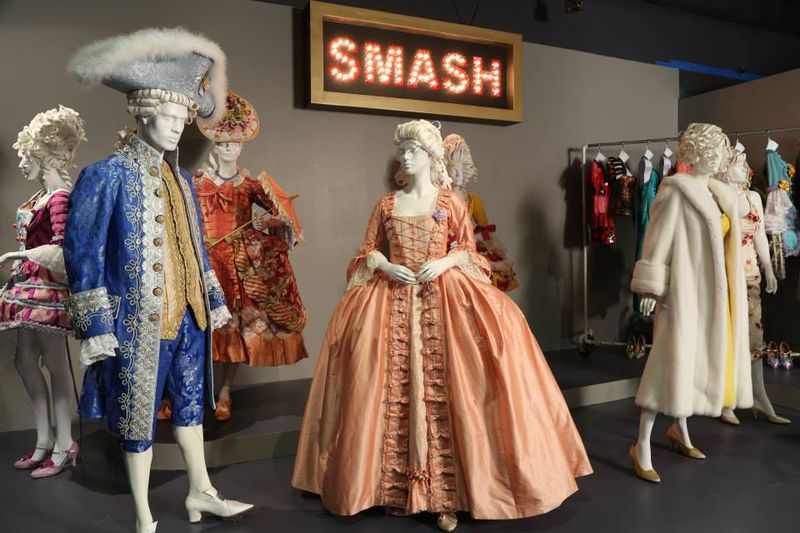 SMASH costumes by Joseph G. Aulisi (L to R) Dancer, Sean Hayes as Terry Falls, Kathy Fitzgerald as Actor #3, Megan Hilty as Ivy Lynn, Dancer, Katharine McPhee as Karen Cartwright, Megan Hilty as Ivy Lynn, Jennifer Hudson as Veronica Moore. (Alex J. Berliner/ABImages)
SMASH costumes by Joseph G. Aulisi (L to R) Dancer, Sean Hayes as Terry Falls, Kathy Fitzgerald as Actor #3, Megan Hilty as Ivy Lynn, Dancer, Katharine McPhee as Karen Cartwright, Megan Hilty as Ivy Lynn, Jennifer Hudson as Veronica Moore. (Alex J. Berliner/ABImages)
The hats are fabulous!
I used wonderful Broadway milliners that I’ve worked with before. But now I had to tell them that I needed a hat in three days, and they were not used to that. We still needed to do hat fittings, and they were danced in, so they really needed to fit. It was just another complication.
Sean Hayes’ shoes were custom made for him, and they were delivered moments before he needed to wear them. They were excruciatingly tight, but being a true trooper, he wore these extremely pointed-toe shoes. He would not wear the looser back up pair with a rounded toe, because he said the pointed toes were funnier.
How many people did you have on your team?
I had three wonderful assistants, a couple costume supervisors, and several people that we added on days when we had 12 to 16 dancers and 10 principals. Most of the manufacturing was done in costume houses that do Broadway musicals or films, and the trick was to get them to turn out high quality work so quickly. For the contemporary costumes, the show wanted new clothes every week. We did an enormous amount of shopping.
Was this a new experience for you?
Many years ago I had done an episodic show Beacon Hill, but things have changed since then.
I’ve been nominated for a couple of Emmys in the past, but those were more like a movie and they were much more contained. (Bernard and Doris in 2006 and Lincoln in 1988)
SMASH was this monster that I was on for 9 months, week after week. It never stopped. The scripts were continually being revised. The show had 12 producers. We’d have a new director each week. Even with all my experience, and all the juggling, it was sort of new and not new.
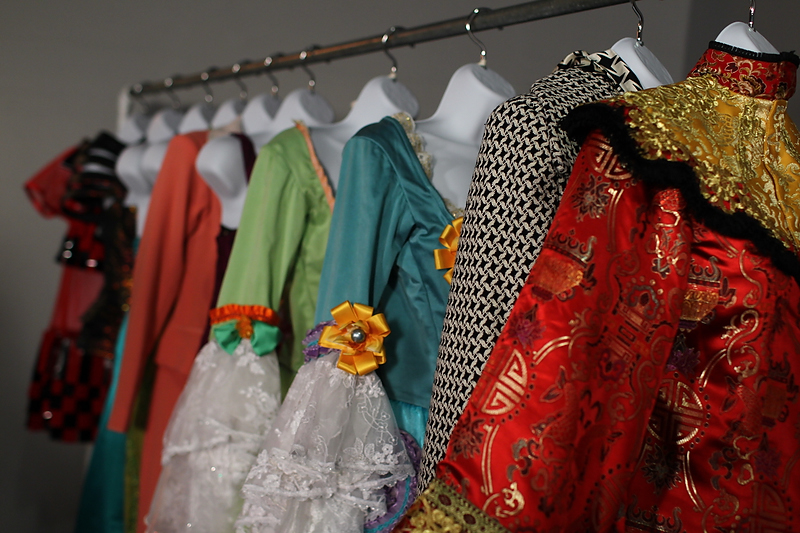 SMASH costumes
SMASH costumes
How did you handle two Marilyns?
Funny story about that. I saw this vintage red and white floral fabric and it was perfect for the seduction scene with JFK. But to add a little life to it, I had a fabric painter add pinks, yellows and green. We had only four yards and we barely squeaked out one costume for the fantasy sequence in episode 3, when Katharine McPhee was Marilyn.
Cut to episode 8 or 9 and they rewrote it, but Megan Hilty is now on stage, in the Broadway musical, as Marilyn. Since the two actors are different sizes, I had to have the fabric reproduced. I changed the dress design a little, but it is basically the same dress done twice.
We are so happy that the red dress worn by Jennifer Hudson is in the exhibition.
Jennifer Hudson arrived on Wednesday at noon for a fitting. Thursday morning she was in the dress to do her scene. The dress was made and ready for her, but we had to adjust the waist seam and redo some of the hand embroidery. We try to find fabric that does most of the work, but for Jennifer we wanted to add the extra embroidery and beading.
But everyone was under the gun. Actors would come for a fitting. A ½ hour later they would be picked up and taken to the recording studio to record a number that they had just learned the day before. The cast was really incredible and professional.
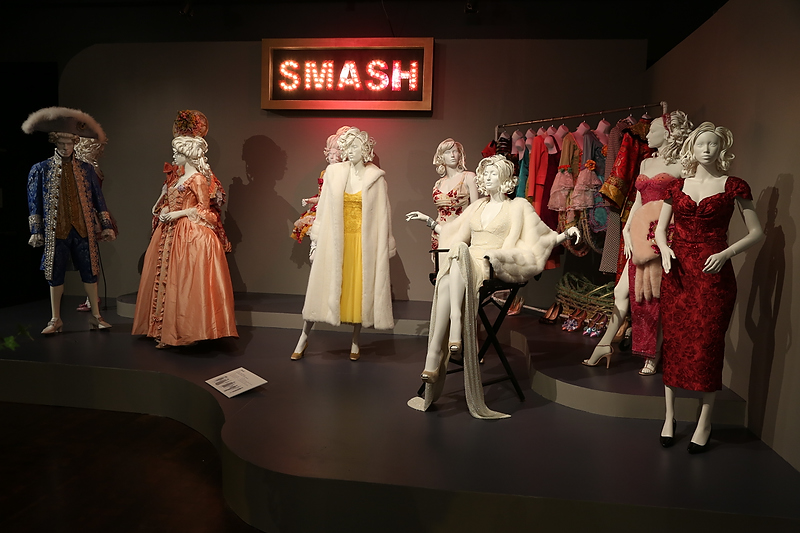 The dress worn by Jennifer Hudson as Veronica Moore is pictured at the far right.
The dress worn by Jennifer Hudson as Veronica Moore is pictured at the far right.
You did the original Shaft!
That was one of my early ones. Strangely enough, that comes back with kids that are 20 years old and are just discovering the whole thing. Shaft was just the right time and the right people. It was just very special, and it was my second or third film.
How did you get started in costume design?
I have always been interested in the theater, in art, and in science, and majored in biology/ premed, with an art minor. After graduating, I came to New York to be an actor.
I auditioned for a Broadway show, The Devils, starring Jason Robards and Ann Bancroft, and was directed by Michael Cacoyannis, the director of Zorba the Greek. I got a part! I played a shellfish salesman and a monk. I loved going to my fittings and talking to the wonderful design team, one of whom was Elizabeth Montgomery. It dawned on me that I wasn’t a very good actor, but I could combine art with theater and that equaled being a designer.
I took a class with the incredible Ann Roth. She gave me an enormous push; I was her assistant on Midnight Cowboy. That was my first film assisting, and it was just Ann and me. Now it would take 20 people. Ann was generous with her time, and she really opened my eyes. Then I assisted other designers, mostly on Broadway.
At the same time that I was meeting my idols, Irene Sharaff, Miles White, and Raoul Pene Du Bois, I was being drafted. When came back, I assisted Irene a couple of times and we became great friends.
My first Broadway play was Man in a Glass Booth, directed by Harold Pinter. I was in my 20s, and it was a wonderful way to start out.
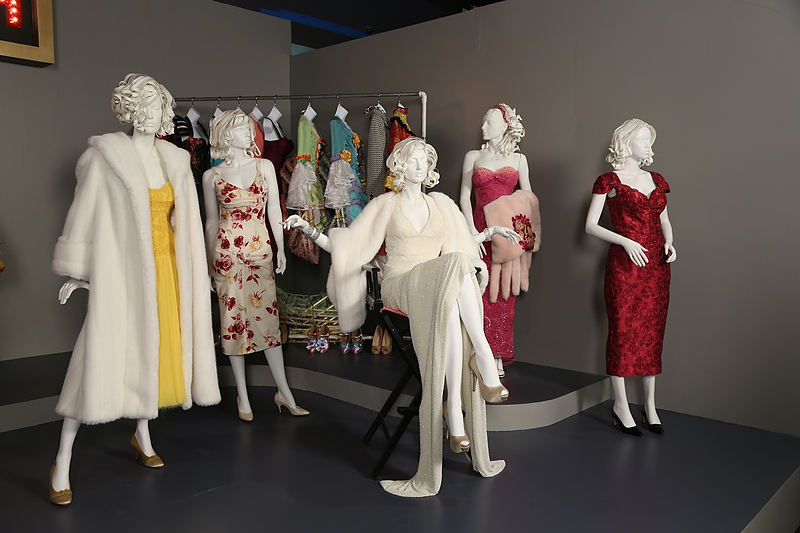 (L to R) Katharine McPhee as Karen Cartwright, Megan Hilty as Ivy Lynn, Jennifer Hudson as Veronica Moore.
(L to R) Katharine McPhee as Karen Cartwright, Megan Hilty as Ivy Lynn, Jennifer Hudson as Veronica Moore.
Are there a couple of challenges from your long career that you could share?
Let’s see—I did the costumes for the first Charlie’s Angel film in three weeks, and when I did Jerome Robbins’ Broadway, I was in charge of creating 600 costumes in six months.
And as much as you want everything to work out and be number one at the box office, I have also worked on Broadway shows for a year, only to see them close in one week. Or I work on a great pilot, and it does not get picked up. Or do a $100 million picture and it fizzles at the box office. So you have to go with those disappointments, which is really just part of the game.
Do you have any advice for young people that want to get into costume design?
Learn as you much as you can—be a sponge—go to museums, and to exhibits like this. Read as much as you can. At museums, look at paintings, see the way that color is used. The really successful people are those that have absorbed a huge amount of knowledge and know-how, and they trust their instincts. We all have our own way, and there is no right way to create something that is original and pleasing, or flattering, or whatever criteria you are trying to achieve. Things like aging and dying fabric, embroidery patterns, knowledge of the theatre, you cannot know too much. Even working with a local theatre company is so enlightening. There is just so much to learn.
You will have to keep us posted on what you do next.
If it is television, it won’t be anything like SMASH. That was a very special television show.